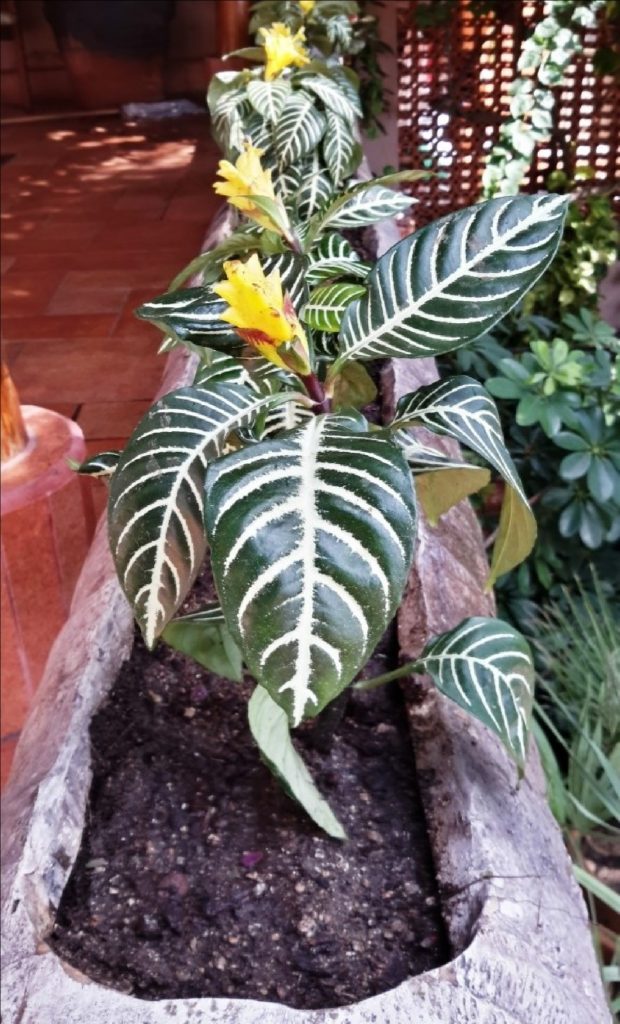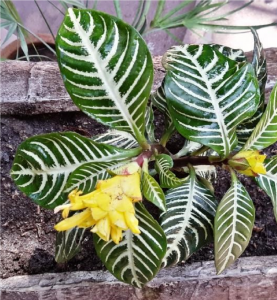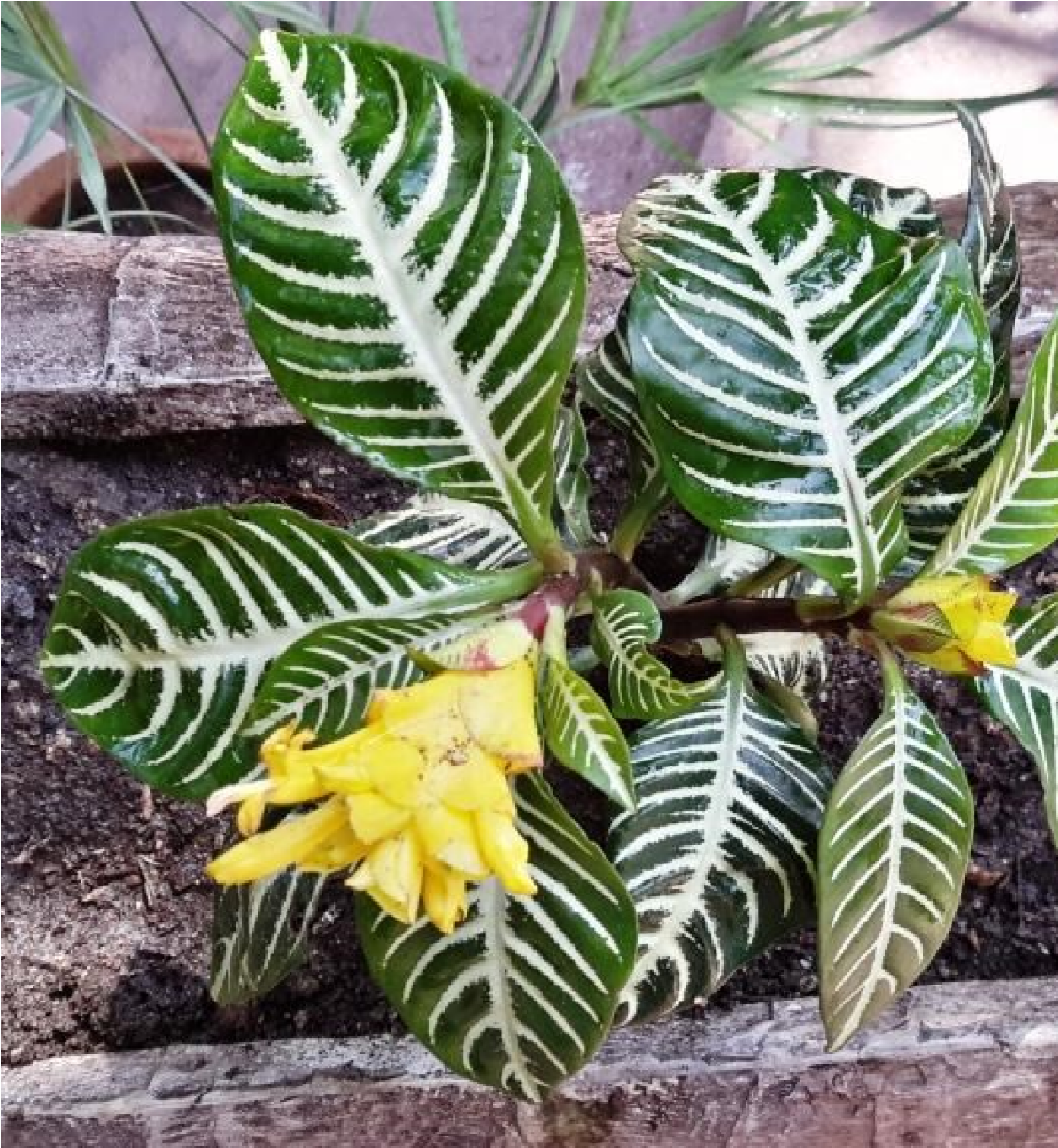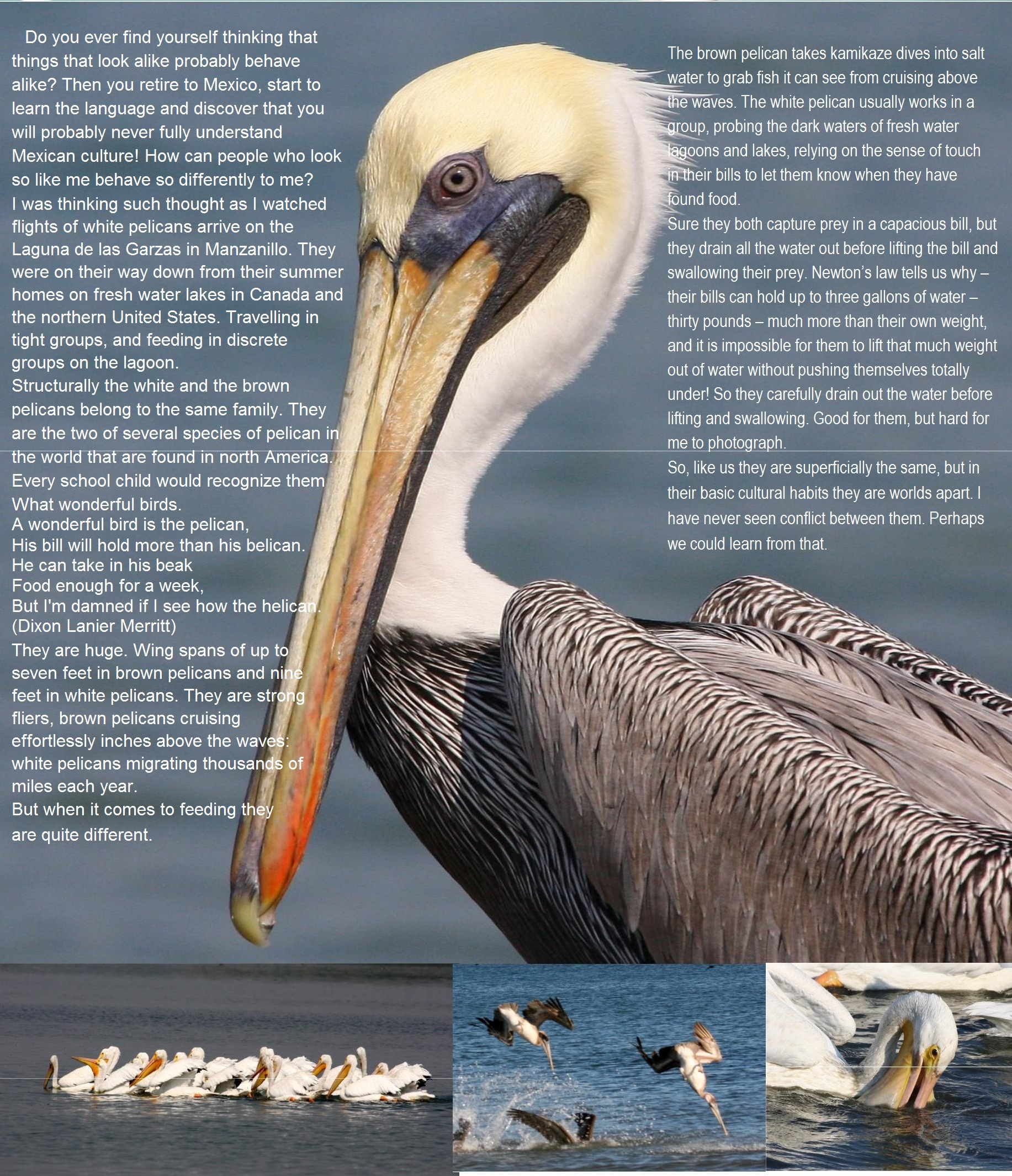By Tommy Clarkson the June 2019 Edition
Aphelandra Squarrosa Aphelandra squarrosa
Family Acanthaceae
Also known as Saffron Spike
(This beauty, most probably, originated in Brazil. But why/how I recall something else, most convolutedly related, is clearly yet another example of my particular thinking process of quirkiness! You see, before I completed US Army Officer Candidate School and became a commissioned officer in my callow youth as a junior enlisted man I rather vividly recall a “performer” billed as the “Brazilian Bombshell” near Fort Knox in Louisville, Kentucky…upon further reflection, perhaps we’d better just leave that story without further elaboration! However, “exceedingly, visually attractive and quite flashy” seem both to be most appropriate in both description of the Zebra Plant and in recollection of her repertoire of talents. A’hhh, Brazilian exports!)

But, youthful reflections put aside, let’s get back to our subject plant. The genus Aphelandra is comprised of more than 200 species, the preponderance of which originated in that large South American country. Those perhaps most commonly seen are this beauty, as well as the A. acutifolia, A. rigida, A. sinclairiana, Aphelandrasquarrosa, A.tetragon and A. tridentata. Most prefer a life in the humid undergrowth.

Casual perusal of the Zebra Plant, adorned by its glossy, dark green colored leaves, streaked with striking, contrasting white-cream veins and yellow, red or orange spikes, sporting small, brownish flowers, explains their allure. These showy, erect, terminal inflorescences are nearly two and a half to nearly six inches (6.35 to 15.24 cm long) tall, sometimes accompanied by two shorter lateral spikes.
It is an erect, compact, evergreen shrub. sometimes exceeding six feet (1.83 meters) in height -however, plants grown indoors or in pots rarely exceed one to two feet (30.48-60.96 cm). On fleshy stems, the simple, opposing, oblong, broadly elliptic, leathery leaves of the Aphelandra squarrosa are of a beautiful intense and bright green color that contrasts with the white veins. They’re light green color on the underside.
It should be located in a very bright place -but not in direct sun and protected from drafts. It requires high temperatures, above 65 °F (18.33°), in summer the ideal would be around 70° to 80° F (21.11°-26.67° C) although, after flowering, you can give a short period of rest with slightly cooler temperatures, but not lower than 58° F (14°C), otherwise, bad things happen!
It requires a well-draining soil kept constantly humid without stagnation; very dry or very wet substrate causes the leave fall. Water frequently at air temperature, making sure that the soil is always wet and does not dry out. During flowering, water it regularly; when flowering finishes, reduce the amount. You might wish to dampen the leaves from time to time, which will help to maintain humidity if the ambient temperature is too high. But, keep in mind -it’s a sensitive sort. Too much or too little water can quickly cause the leaves to drop.
The leaves can be cleaned occasionally with a soft, damp cloth, while holding them with one hand to prevent breakage. If potted, maintain the humidity of the plant by placing the pot on a wide plate, saucer filled with gravel or flat, broken tile pieces so as to ensure that it doesn’t come into direct contact with the bottom of the pot. This could cause the roots to rot.
If it is losing leaves, that’s generally a result of being improperly located with either too much sun or more cool temps than it wants. The Aphelandra squarrosa prefers its root feet in a mix of one part sand, another of mulch, and two parts of fibra de coco(coir or coconut fiber)which I acquire in massive bales!
I encourage that you water it frequently to prevent the soil from drying out. Feed it every two weeks, during the growing season, with a diluted liquid fertilizer. It does not need some sort of highly scientific pruning -merely cut the flower spikes when they wither so that new buds might emerge. When the flower spike begins to form, increase its feeding to once a week. A good balanced fertilizer is equal proportions of nitrogen, phosphorus and potassium, such as marked on the package 30:30:30.
Zebra Plants can most easily be reproduced by springtime cuttings. But, regardless of its age or size, in dry environs they can be attacked by woodlice and aphids. And, lastly, while not considered as poisonous to pets, its sap can cause skin irritation in some people who have certain allergies.
The full edition or view it online
—
Tommy Clarkson is a bit of a renaissance man. He’s lived and worked in locales as disparate as the 1.2 square mile island of Kwajalein to war-torn Iraq, from aboard he and Patty’s boat berthed out of Sea Bright, NJ to Thailand, Germany, Hawaii and Viet Nam; He’s taught classes and courses on creative writing and mass communications from the elementary grades to graduate level; He’s spoken to a wide array of meetings, conferences and assemblages on topics as varied as Buddhism, strategic marketing and tropical plants; In the latter category he and Patty’s recently book, “The Civilized Jungle” – written for the lay gardener – has been heralded as “the best tropical plant book in the last ten years”; And, according to Trip Advisor, their spectacular tropical creation – Ola Brisa Gardens – is the “Number One Tour destination in Manzanillo”.




